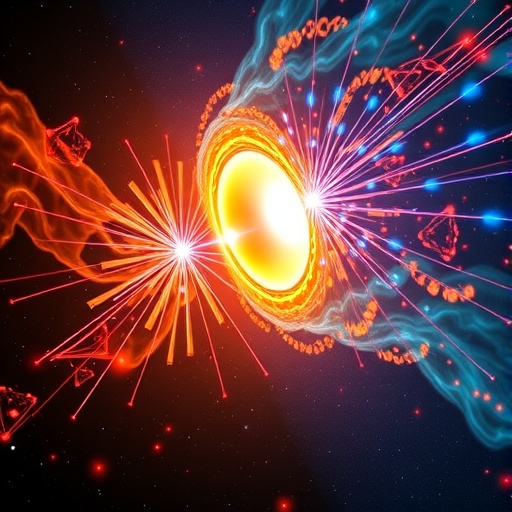Researchers at the Shanghai Astronomical Observatory (SHAO) of the Chinese Academy of Sciences have made a groundbreaking discovery regarding the flow of gas in massive star formation, revealing intricate details of how material from great distances converges into the dense disks surrounding nascent massive stars. This study offers a unique glimpse into the complex processes governing the birth of massive stars, which are pivotal in shaping the evolution of galaxies and the interstellar medium.
Massive stars, defined as those exceeding eight solar masses, play a crucial role in the cosmos. They influence cosmic evolution through their powerful radiation, stellar winds, and explosive deaths as supernovae, which dramatically alter the surrounding interstellar environment. Unlike their low-mass counterparts, which often form through straightforward gravitational collapse, the origins of massive stars are labyrinthine, taking place in highly dynamic and large-scale gas environments. Prior to this research, the step-by-step transport of gas into these structures to form accretion disks remained elusive, leaving researchers with questions about the underlying mechanisms.
Utilizing the renowned Atacama Large Millimeter/submillimeter Array (ALMA) in conjunction with maser astrometry—a technique that employs microwaves to pinpoint gas positions—scientists meticulously traced the gas accretion process in a specific massive star-forming region. Amplifying their observational capabilities, the researchers incorporated data from the Very Large Array (VLA), an advanced radio telescope located in New Mexico, USA.
The scope of their research spanned distances from approximately 2,500 astronomical units (AU) down to 40 AU from the protostar, illustrating how gas moves closer to the center of star formation. This is particularly significant because one astronomical unit is equivalent to the mean distance from the Earth to the Sun. Their findings, published on September 17, were lauded for providing a “textbook case” that elucidates the hierarchical structures and gas accretion processes unique to massive star formation.
The observations focused on the massive star-forming region known as IRAS 18134-1942, which is situated about 1.25 kiloparsecs from the Sun. The researchers unveiled a striking, layered architecture of gas flows that mirrored complex cosmic structures. At the broadest scale, they identified numerous spiral-like streams that guide gas inwardly, sculpted by the parent cloud’s rotation and collapse. As these streams converge, they form a distinct, elongated bar-like structure funneling gas further towards the center. As one approaches the protostar, the gas transforms into a rotating envelope, and as this evolution culminates within a few hundred AU, an accretion disk presenting Keplerian rotation emerges.
The revelations of this study highlight an unexpected efficiency in the transport of gas. Research indicated that the inflow rate maintained a steady average of roughly one ten-thousandth of a solar mass per year within the spiral and bar structures. However, this rate dwindled to about one millionth of a solar mass per year at the scale of the disk. Consequently, this suggests a regulatory function among the envelope and disk, fundamentally influencing the growth efficiency of protostars.
Moreover, researchers identified an intriguing misalignment in the rotation axis of the envelope compared to the protostellar disk. This misalignment, while not a direct reversal, points toward the influence of turbulent inflows imparting uneven angular momentum during the accretion process. The findings challenge previous assumptions about the chaotic nature of gas dynamics in these environments, revealing that the internal structures of massive molecular clouds exhibit highly organized, galaxy-like hierarchical patterns.
Dr. MAI Xiaofeng, a prominent astronomer from SHAO and the study’s first and corresponding author, emphasized the significance of these results. He remarked that the findings provide pivotal observational evidence regarding how massive stars gather mass and form their accretion disks in complex environments. This evidence challenges long-standing views and opens avenues for fresh exploration in the study of stellar formation.
The effort is part of the ambitious international ALMA-ATOMS/QUARKS survey, which has been diligently accruing multiscale data from over 140 massive star-forming regions over the last five years. This expansive database enhances the understanding of star formation processes across different cosmic settings.
Building upon this foundational research, Dr. LIU Tie, the project leader and co-corresponding author, expressed the team’s ambition to study additional systems utilizing ALMA and ongoing follow-up observations, in tandem with advanced numerical simulations. This integrated approach aims to further unveil the comprehensive dynamics involved in massive star creation, culminating in a broader understanding of stellar evolution.
Through this pioneering work, researchers at SHAO have set the stage for a new chapter in astrophysical research, illuminating the complexities of massive star formation. As the team continues to investigate the intricate web of gas dynamics, they hope to unveil even more insights that can revolutionize the field of astrophysics and deepen our comprehension of the universe’s fundamental processes.
This research not only contributes essential knowledge to the field but also raises intriguing questions about the interplay between massive stars and the broader cosmic environment, prompting further inquiry into the fundamental mechanisms that govern the lifecycle of stars and galaxies.
Subject of Research: Gas accretion processes in massive star formation
Article Title: A misaligned protostellar disk fed by gas streamers in a barred spiral-like massive dense core
News Publication Date: 17-Sep-2025
Web References: DOI
References: N/A
Image Credits: Credit: SHAO
Keywords
Massive stars, star formation, gas accretion, accretion disks, ALMA, VLA, hierarchical structures, astrophysics, cosmic evolution.




